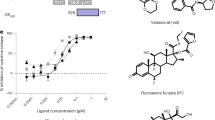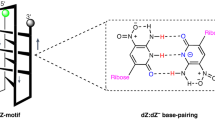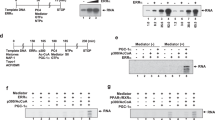Abstract
Steroid receptors recognize bipartite targets composed of six base-pair half-sites. There are two canonical types of half-site which differ only in their central two base pairs. The crystal structure of an estrogen receptor-like DNA-binding domain bound to the wrong type of half-site (a glucocorticoid response element) reveals an interface that resembles the specific interfaces of the glucocorticoid receptor or estrogen receptor bound to their correct response elements. The underlying stereochemical defect that weakens the non-cognate interface is a difference in the helical geometry of the incorrect DNA half-site which prevents a side-chain contact and results in a gap which is filled by at least five additional fixed water sites, imposing a potential entropic burden on the stability of the interface.
This is a preview of subscription content, access via your institution
Access options
Subscribe to this journal
Receive 12 print issues and online access
$259.00 per year
only $21.58 per issue
Buy this article
- Purchase on SpringerLink
- Instant access to full article PDF
Prices may be subject to local taxes which are calculated during checkout
Similar content being viewed by others
References
Evans, R.M. The steroid and thyroid hormone receptor superfamily. Science 240, 889–895 (1988).
Beato, M. Gene regulation by steroid hormones. Cell 56, 335–344 (1989).
Parker, M.G. Nuclear Hormone Receptors (Academic Press, London, 1991).
Klock, G., Strahle, U. & Schutz, G. Oestrogen and glucocorticoid responsive elements are closely related but distinct. Nature 329, 734–736 (1987).
Naar, A.M. et al. The orientation and spacing of core DNA-binding motifs dictate selective transcriptional responses to three nuclear receptors. Cell 65, 1267–1279 (1991).
Umesono, K., Murakami, K.K., Thompson, C.C. & Evans, R.M. Direct repeats as selective response elements for the thyroid hormone, retinoic acid, and vitamin D3 receptors. Cell 65, 1255–1266 (1991).
Kumar, V. & Chambon, P. The estrogen receptor binds tightly to its responsive element as a ligand-induced homodimer. Cell 55, 145–156 (1988).
Tsai, S.Y. et al. Molecular interactions of steroid hormone receptor with its enhancer element: evidence for receptor dimer formation. Cell 55, 361–369 (1988).
Yu, V.C. et al. RXR beta: a coregulator that enhances binding of retinoic acid, thyroid hormone, and vitamin D receptors to their cognate response elements. Cell 67, 1251–1266 (1991).
Zhang, X.K. et al. Homodimer formation of retinoid X receptor induced by 9-cis retinoic acid. Nature 358, 587–591 (1992).
Kliewer, S.A., Umesono, K., Noonan, D.J., Heyman, R.A. & Evans, R.M. Convergence of 9-cis retinoic acid and peroxisome proliferator signalling pathways through heterodimer formation of their receptors. Nature 358, 771–774 (1992).
Kliewer, S.A., Umesono, K., Mangelsdorf, D.J. & Evans, R.M. Retinoid X receptor interacts with nuclear receptors in retinoic acid, thyroid hormone and vitamin D3 signalling. Nature 355, 446–9 (1992).
Leid, M. et al. Purification, cloning, and RXR identity of the HeLa cell factor with which RAR or TR heterodimerizes to bind target sequences efficiently. Cell 68, 377–395 (1992).
Marks, M.S. et al. H-2RIIBP (RXR beta) heterodimerization provides a mechanism for combinatorial diversity in the regulation of retinoic acid and thyroid hormone responsive genes. EMBO J. 11, 1419–1435 (1992).
Luisi, B.F. et al. Crystallographic analysis of the interaction of the glucocorticoid receptor with DNA. Nature 352, 497–505 (1991).
Schwabe, J.W. Chapman, L., Finch, J.T. & Rhodes, D. The crystal structure of the estrogen receptor DNA-binding domain bound to DNA: how receptors discriminate between their response elements. Cell 75, 567–578 (1993).
Hard, T. et al. Solution structure of the glucocorticoid receptor DNA-binding domain. Science 249, 157–160 (1990).
Schwabe, J.W., Neuhaus, D. & Rhodes, D. Solution structure of the DNA-binding domain of the oestrogen receptor. Nature 348, 458–461 (1990).
Baumann, H. et al. Refined solution structure of the glucocorticoid receptorDNA-bindingdomain. Biochemistry 32, 13463–13471 (1993).
Green, S. & Chambon, P. Oestradiol induction of a glucocorticoid-responsive gene by a chimaeric receptor. Nature 325, 75–78 (1987).
Green, S., Kumar, V., Theulaz, I., Wahli, W. & Chambon, P., DNA-binding ‘zinc finger’ of the oestrogen and glucocorticoid receptors determines target gene specificity. EMBO J. 7, 3037–3044 (1988).
Danielsen, M., Hinck, L. & Ringold, G.M. Two amino acids within the knuckle of the first zinc finger specify DNA response element activation by the glucocorticoid receptor. Cell 57, 1131–1138 (1989).
Mader, S., Kumar, V., de Verneuil, H. & Chambon, P. Three amino acids of the oestrogen receptor are essential to its ability to distinguish an oestrogen from a glucocorticoid-responsive element. Nature 338, 271–274 (1989).
Umesono, K. & Evans, R.M. Determinants of target gene specificity for steroid/thyroid hormone receptors. Cell 57, 1139–1346 (1989).
Zilliacus, J., Dahlman-Wright, K., Wright, A., Gustafsson, J.A. & Carlstedt-Duke, J. DNA binding specificity of mutant glucocorticoid receptor DNA-binding domains. J. biol. Chem. 266, 3101–3106 (1991).
Alroy, I. & Freedman, L.P. DNA binding analysis of glucocorticoid receptor specificity mutants. Nucleic Acids Res. 20, 1045–1052 (1992).
Lundback, T., Cairns, C., Gustafsson, J.A., Carlstedt-Duke, J. & Hard, T. Thermodynamics of the glucocorticoid receptor-DNA interaction: binding of wild-type GR DBD to different response elements. Biochemistry 32, 5074–5082 (1993).
Dahlman-Wright, K., Siltala-Roos, H., Carlstedt-Duke, J. & Gustafsson, J.A. Protein-protein interactions facilitate DNA binding by the glucocorticoid receptor DNA-binding domain. J. biol. Chem. 265, 14030–14035 (1990).
Ladbury, J.E., Wright, J.G., Sturtevant, J.M. & Sigler, P.B. A thermodynamic study of the trp repressor-operator interaction. J. molec. Biol. 238, 669–6681 (1994).
Rastinejad, F., Perlmann, T., Evans, R.M. & Sigler, P.B. Structural determinants of nuclear receptor assembly on DNA direct repeats. Nature, in the press.
Lundback, T., Zilliacus, J., Gustafsson, J.A., Carlstedt-Duke, J. & Hard, T. Thermodynamics of sequence-specific glucocorticoid receptor-DNA interactions. Biochemistry 33, 5955–5965 (1994).
Brünger, A.T. X-PLOR, Version 3.1: A System for Crystallography and NMR (Yale University Press, New Haven; 1992).
Lavery, R. & Sklenar, H. Defining the structure of irregular nucleic acids: conventions and principles. J. biomolec.Struct. Dynam. 6, 655–667 (1989).
Author information
Authors and Affiliations
Rights and permissions
About this article
Cite this article
Gewirth, D., Sigler, P. The basis for half-site specificity explored through a non-cognate steroid receptor-DNA complex. Nat Struct Mol Biol 2, 386–394 (1995). https://doi.org/10.1038/nsb0595-386
Received:
Accepted:
Issue date:
DOI: https://doi.org/10.1038/nsb0595-386
This article is cited by
-
Structural Basis of Natural Promoter Recognition by the Retinoid X Nuclear Receptor
Scientific Reports (2015)
-
Estrogen receptor transcription and transactivation Structure-function relationship in DNA- and ligand-binding domains of estrogen receptors
Breast Cancer Research (2000)
-
Structure of α-lytic protease complexed with its pro region
Nature Structural Biology (1998)
-
A recipe for specificity
Nature Structural & Molecular Biology (1995)



